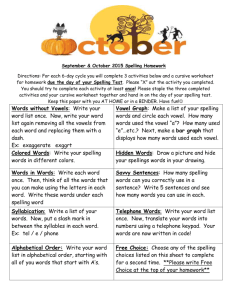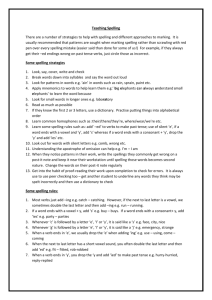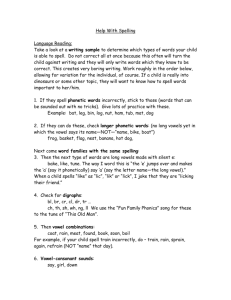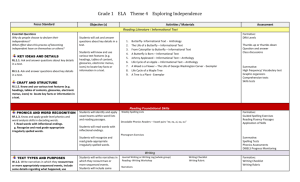Theme 3 Lesson Plans
advertisement
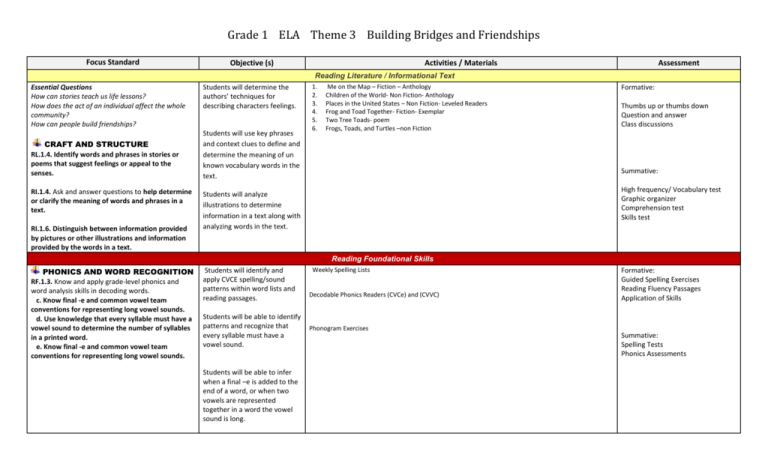
Grade 1 ELA Theme 3 Building Bridges and Friendships Focus Standard Objective (s) Activities / Materials Assessment Reading Literature / Informational Text Essential Questions How can stories teach us life lessons? How does the act of an individual affect the whole community? How can people build friendships? CRAFT AND STRUCTURE RL.1.4. Identify words and phrases in stories or poems that suggest feelings or appeal to the senses. RI.1.4. Ask and answer questions to help determine or clarify the meaning of words and phrases in a text. RI.1.6. Distinguish between information provided by pictures or other illustrations and information provided by the words in a text. Students will determine the authors’ techniques for describing characters feelings. Students will use key phrases and context clues to define and determine the meaning of un known vocabulary words in the text. 1. 2. 3. 4. 5. 6. Me on the Map – Fiction – Anthology Children of the World- Non Fiction- Anthology Places in the United States – Non Fiction- Leveled Readers Frog and Toad Together- Fiction- Exemplar Two Tree Toads- poem Frogs, Toads, and Turtles –non Fiction Formative: Thumbs up or thumbs down Question and answer Class discussions Summative: High frequency/ Vocabulary test Graphic organizer Comprehension test Skills test Students will analyze illustrations to determine information in a text along with analyzing words in the text. Reading Foundational Skills PHONICS AND WORD RECOGNITION RF.1.3. Know and apply grade-level phonics and word analysis skills in decoding words. c. Know final -e and common vowel team conventions for representing long vowel sounds. d. Use knowledge that every syllable must have a vowel sound to determine the number of syllables in a printed word. e. Know final -e and common vowel team conventions for representing long vowel sounds. Students will identify and apply CVCE spelling/sound patterns within word lists and reading passages. Students will be able to identify patterns and recognize that every syllable must have a vowel sound. Students will be able to infer when a final –e is added to the end of a word, or when two vowels are represented together in a word the vowel sound is long. Weekly Spelling Lists Decodable Phonics Readers (CVCe) and (CVVC) Phonogram Exercises Formative: Guided Spelling Exercises Reading Fluency Passages Application of Skills Summative: Spelling Tests Phonics Assessments Grade 1 ELA Theme 3 Building Bridges and Friendships Writing PRODUCTION AND DISTRIBUTION OF WRITING W.1.5. With guidance and support from adults, focus on a topic, respond to questions and suggestions from peers, and add details to strengthen writing as needed. W.1.6. With guidance and support from adults, use a variety of digital tools to produce and publish writing, including in collaboration with peers. Students will respond in a written form to a specific prompt appropriate to the selected text. Journal Writing or Writing Log (whole group) Reading -Writing Workshop Writing a Class Letter Writing Checklist Writing Rubric Formative: Summative: Students will respond in a written form to a specific prompt appropriate to the selected text. Students will plan and develop a personal narrative using all steps of the writing process. 1. Pre-writing 2. Drafting 3. Revising 4. Proofreading 5. Publishing Letter of Persuasion Writing a Description Graphic Organizers Revising Checklist Personal Narrative Writing Samples/Rubric Language CONVENTIONS OF STANDARD ENGLISH L.1.2. Demonstrate command of the conventions of standard English capitalization, punctuation, and spelling when writing. a. Capitalize dates and names of people. b. Use end punctuation for sentences. c. Use commas in dates and to separate single words in a series. d. Use conventional spelling for words with common spelling patterns and for frequently occurring irregular words. e. Spell untaught words phonetically, drawing on phonemic awareness and spelling conventions. Students will apply basic capitalization and punctuation in their writing: First word in a sentence Proper names Period to end declarative sentence Question mark to end interrogative sentence. Students will use phonic knowledge and basic patterns to spell correctly three and four letter words. High Frequency Word Lists Spelling Units Writing Prompts Formative: Individual Observation Journal Writing Summative: Friendly Letter Rubric High Frequency Word Tests Spelling Unit Tests Grade 1 ELA Theme 3 Building Bridges and Friendships Graphic Organizers Speaking and Listening COMPREHENSION AND COLLABORATION SL.1.1. Participate in collaborative conversations with diverse partners about grade 1 topics and texts with peers and adults in small and larger groups. a. Follow agreed-upon rules for discussions (e.g., listening to others with care, speaking one at a time about the topics and texts under discussion). b. Build on others’ talk in conversations by responding to the comments of others through multiple exchanges. c. Ask questions to clear up any confusion about the topics and texts under discussion. Students will engage in collaborative conversations about grade-appropriate topics and texts. The students will engage in small group discussions (listening and speaking centers) about the stories and will actively engage in question asking. Students will describe the people, places, and events that are in the stories with clear ideas and feelings. They will express their thoughts and feelings about the stories. Formative: Daily discussions on comprehension story topics. Observing students’ active engagement in small groups Summative: Comprehension tests at the end of the theme.


